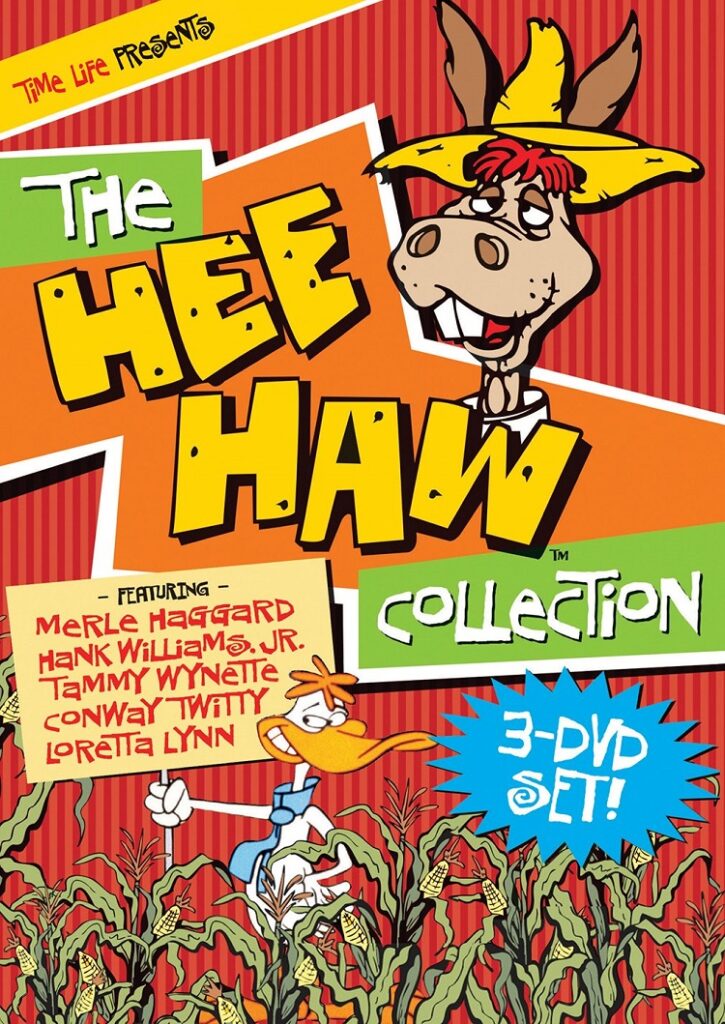
The first hour of watching The Hee Haw Collection might have been the longest hour of anything I’ve seen. The leaden jokes, hideous animations, Buck Owen’s fake hair, Grandpa Jones frailing the banjo while it was being played Scruggs-style on the playback. Every few minutes there might be a music performance that would lift me back up just to kick me in the teeth with more… humor.
By the end of the second episode, something had shifted, slightly. It may have helped that the second episode here was from the third season – these Time Life Presents collections apparently randomly select episodes from throughout the series’ run. It was certainly a more polished production than the earlier episode – or more intentionally unpolished, since Hee Haw‘s entire appeal is of the “let’s paint the barn and put on a show!” cheapness variety. It also went further into the formula that made Hee Haw a bafflingly long-lived success: more songs (including sing a-longs with the whole Hee Haw crew) and more girls with skimpy clothing.
There are five episodes on this three DVD-set (Episodes 13, 56, 99, 15, 19) and I watched them in that order, as they were presented on the disc. A weird phenomenon took place that I can only describe as a strange sense of Hee Haw Stockholm Syndrome: by the time I was near the end of the second episode, I might have laughed a couple of times.
The humor certainly did not get better, and the interviews on the disc show that it was certainly meant to be terrible cornpone hackery. But it was rapid-fire cornpone hackery, featuring the same players again and again and not trying too hard. Maybe it was just from exposure, but as the episodes wore on I began to develop an affection for the wide and varied cast. The regulars were all legends in the live country scene – Grandpa Jones, David “Stringbean” Akeman, and others, and the hosts were the legendary Buck Owens and comedian/musician Roy Clark. Other country comedians or personalities show up – the Hagar twins, Archie Campbell, Minnie Pearl and George Lindsey among them. There are also the genuine oddities like gargantuan Lulu Roman and Junior Samples, both of dubious talent but neither like anyone else one would see on TV (in interviews it’s revealed that Lulu was actually a flower child who had no idea who any of these country people were, and Junior Samples was a true backwoods man with a third-grade education, whose inability to read large words on cue cards was a running gag.)
It might simply be a phenomenon of television, and the reason even the most execrable reality TV can be addictive – when you spend time looking at people, on a screen, whatever they’re doing, it’s human nature to develop an attachment to them. At first, everyone on Hee Haw seems like a joke. Then, as you get more used to it, and the faces become familiar, you get to be in on the joke.
There are two palliatives in the mix that I think serve to ease the transition from Hee Haw-phobic to, at least tolerant, if not a Hee Haw supporter: great music and pretty girls. Taken in the opposite order, there were attractive females in the show from the beginning. In the interstitials between sketches the terribly pretty, bubbly Cathy Baker would pop up and generally say something silly, then the next sketch would start. At the end of every episode, she’s the smiling face that says, “That’s all.” She was a genuine Texan, while the other girls came from all over (and more than a few graced the pages of Playboy in the ’70s).
Looking at pretty girls tell terrible jokes is a very momentary pleasure. The music on Hee Haw is much more substantive, and makes a much easier case for why Hee Haw was such a mainstay for so long on television. Though it is all country and western, it was a wide breadth of country and western, with artists huge and relatively obscure performing, often several times an episode. One of the reasons that Hee Haw was shot in Nashville was to have access to the musical talent there, so each episode can have multiple performances by Merle Haggard, Loretta Lynne, and Tammy Wynette generally singing hits, but singing them to a television audience that might not have ever gotten a chance to see these stars for themselves. And of course, Buck Owens regularly performed backed by his world class Buckaroos, and Roy Clark would sing or play virtuoso guitar instrumentals.
In those moments it’s a hell of a show. In the other moments… I can see why others may have developed an affection for the show. This collection (which is merely titled The Hee Haw Collection, with no volume number) contains five episodes, several interviews, and a 30 minute collection of sketches (no music interludes) that was, I believe, previously available as video release. The quality of the materials is spotty. It was either shot or archived on video, which naturally limits how good this stuff can look or sound – but that’s got to be a small concern to Hee Haw fans.
If you’re one of these, and want a random slice of it to show the kids (after tying them down so they can’t run away after 30 seconds) it may well work. The show went for 23 seasons and more than 300 episodes, so it would be impossible in this small slice to present what one might call a truly representative collection.
For the merely curious, I delved in. I came out alive, and with an understanding of why Hee Haw might appeal to folks. I can’t imagine going back for any more, but this sample left me more respectful and less dismissive of the series as a whole.